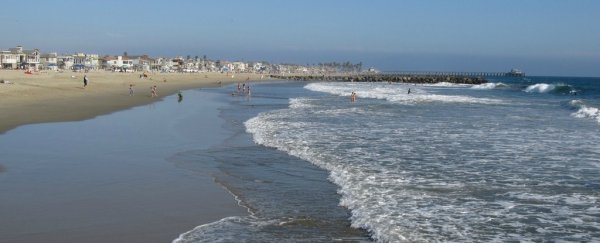Being surrounded by iridescent turquoise beaches for 10 days has a way of getting you to ask the tough questions.
Questions like: "Why are some beaches graced with perfectly clear water, while others seem to get stuck with the murky grey stuff?"
Fortunately for those of us who live near greyish waters, the answer almost never has to do with the amount of human pollution nearby. As it happens, several factors play a role in distinguishing the sparkly, blue water of certain coasts from the dirty, puddle-like water on other beaches - from the rotation of the planet to the ingredients in the water.
Earth spins
The water in Earth's oceans moves from west to east as a result of the planet's rotation. This movement creates a phenomenon known as upwelling along certain coasts, wherein the warmer surface waters of the ocean move out to sea and are replaced by deeper, colder, sediment-rich waters.
In the Pacific Ocean - a body of water that extends from the east coast of Japan, the Philippines, and Australia all the way to the west coast of the US, western Mexico, and Chile - this has a side effect of turning some waters brownish-grey.
By contrast, the waters off the Bahamas and the Dominican Republic don't experience this kind of upwelling. Reefs and other physical structures off their coasts act as barriers, breaking the force of the moving water and dispersing its energy. So by the time waves reach the coast, they're too calm to generate the sort of water-churning patterns that stir up the waters of Santa Barbara or San Diego.
But it's not just the Bahamas or the Dominican Republic that have crystal-clear oceans, and calm waters aren't the only factor at work here.
Certain bodies of water, like those off the coasts of the Philippines or Hawaii or those bordering the Turks and Caicos Islands, for example, may have lots of waves and still remain clear. In these areas, the water's clarity has more to do with what's in the water than what's around it.
It's about what's in the water
Somewhat counterintuitively, cloudy, greyish-looking water is often richer in nutrients than clear, sparkling water. That's because that murky water is typically home to more living organisms, including phytoplankton (algae) and zooplankton (jellyfish and other ocean-wandering animals), which in turn make the water appear cloudy.
Sediments play a role in this, too. Along certain coasts, finer particles like sand and silt can add to the water's murkiness since they're easily agitated and stay afloat for long periods. On the other hand, the sediments off clearer coasts may be heavier and coarser. Instead of fine sand, these sediments are often made up of things like pieces of shells and chunks of dead coral, which are often tougher to stir up.
So there you have it - some beaches may be murkier-looking than others, but it doesn't necessarily mean they're dirtier or any less worthy of enjoying!
This article was originally published by Business Insider.
More from Business Insider:
